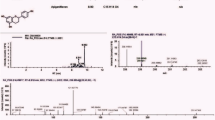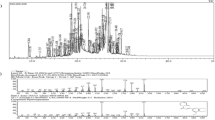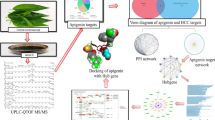Abstract
In pancreatic cancer, healthy cells in the pancreas begin to malfunction and proliferate out of control. According to our conventional knowledge, many plants contain several novel bioactive compounds, having pharmaceutical applications for the treatment of disease like pancreatic cancer. The methanolic fraction of fruit extract of Trema orientalis L. (MFETO) was analysed through HRMS. In this in silico study, pharmacokinetic and physicochemical properties of the identified flavonoids from MFETO were screened out by ADMET analysis. Kaempferol and catechin followed Lipinski rules and showed no toxicity in Protox II. Targets of these compounds were taken from SwissTarget prediction and TCMSP whilst targets for pancreatic cancer were taken from GeneCards and DisGeNET databases. The protein–protein interaction (PPI) network of common genes was generated through STRING and then exported to the Cytoscape to get top 5 hub genes (AKT1, SRC, EGFR, TNF, and CASP3). The interaction between compounds and hub genes was analysed using molecular docking, and high binding affinity between them can be visualised by Biovia discovery studio visualizer. Our study shows that, five hub genes related to pancreatic cancer play an important role in tumour growth induction, invasion and migration. Kaempferol effectively check cell migration by inhibiting ERK1/2, EGFR-related SRC, and AKT pathways by scavenging ROS whilst catechin inhibited TNFα-induced activation and cell cycle arrest at G1 and G2/M phases by induction of apoptosis of malignant cells. Kaempferol and catechin containing MFETO can be used for formulation of potent drugs for pancreatic cancer treatment in future.









Similar content being viewed by others
Data availability
The data that support the findings of this study are available from public databases.
References
US Preventive Services Task Force, Owens DK, Davidson KW, Krist AH, Barry MJ, Cabana M, Caughey AB, Curry SJ, Doubeni CA, Epling JW Jr, Kubik M, Landefeld CS, Mangione CM, Pbert L, Silverstein M, Simon MA, Tseng CW, Wong JB. Screening for pancreatic cancer: US preventive services task force reaffirmation recommendation statement. JAMA. 2019;322(5):438–444. doi: https://doi.org/10.1001/jama.2019.10232
Jin C, Bai L. Pancreatic cancer – current situation and challenges. Gastroenterol Hepatol Lett. 2020;2(1):1–3. https://doi.org/10.18063/ghl.v2i1.243.
Chang MC, Wong JM, Chang YT. Screening and early detection of pancreatic cancer in high risk population. World J Gastroenterol. 2014;20(9):2358–64. https://doi.org/10.3748/wjg.v20.i9.2358.
Ohmoto A, Yachida S, Morizane C. Genomic features and clinical management of patients with hereditary pancreatic cancer syndromes and familial pancreatic cancer. Int J Mol Sci. 2019;20(3):561. https://doi.org/10.3390/ijms20030561.
Yue Q, Gao G, Zou G, Yu H, Zheng X. Natural products as adjunctive treatment for pancreatic cancer: recent trends and advancements. Biomed Res Int. 2017;2017:8412508. https://doi.org/10.1155/2017/8412508.
Stan SD, Singh SV, Brand RE. Chemoprevention strategies for pancreatic cancer. Nat Rev Gastroenterol Hepatol. 2010;7(6):347–56. https://doi.org/10.1038/nrgastro.2010.61.
Ying J-E, Zhu L-M, Liu B-X. Developments in metastatic pancreatic cancer: is gemcitabine still the standard? World J Gastroenterol. 2012;18(8):736–45. https://doi.org/10.3748/wjg.v18.i8.736.
Akinleye A, Iragavarapu C, Furqan M, Cang S, Liu D. Novel agents for advanced pancreatic cancer. Oncotarget. 2015;6(37):39521–37. https://doi.org/10.18632/oncotarget.3999.
Hu JX, Zhao CF, Chen WB, Liu QC, Li QW, Lin YY, Gao F. Pancreatic cancer: a review of epidemiology, trend, and risk factors. World J Gastroenterol. 2021;27(27):4298–321. https://doi.org/10.3748/wjg.v27.i27.4298.
Schwarz RE, Donohue CA, Sadava D, Kane SE. Pancreatic cancer in vitro toxicity mediated by Chinese herbs SPES and PC-SPES: implications for monotherapy and combination treatment. Cancer Lett. 2003;189(1):59–68. https://doi.org/10.1016/s0304-3835(02)00501-3.
Napiroon T, Tanruean K, Poolprasert P, Bacher M, Balslev H, Poopath M, Santimaleeworagun W. Cannabinoids from inflorescences fractions of Trema orientalis (L) Blume (Cannabaceae) against human pathogenic bacteria. PeerJ. 2021;9:e11446. https://doi.org/10.7717/peerj.11446.
Adinortey MB, Galyuon IK, Asamoah NO. Trema orientalis Linn. Blume: A potential for prospecting for drugs for various uses. Pharmacogn Rev. 2013;7(13):67–72. https://doi.org/10.4103/0973-7847.112852.
Parvez A, Azad M, Islam M, Munna MM, Shaheen S, Rahman MM. A phytochemical and pharmacological review on Trema orientalis: a potential medicinal plant. Pharmacologyonline. 2019;3:103–19.
Kumar P, Singh AK, Verma P, Tiwari KN, Mishra SK. Network pharmacology-based study on apigenin present in the methanolic fraction of leaves extract of Cestrum nocturnum L to uncover mechanism of action on hepatocellular carcinoma. Med Oncol. 2022;39(10):155. https://doi.org/10.1007/s12032-022-01759-z.
Kopustinskiene DM, Jakstas V, Savickas A, Bernatoniene J. Flavonoids as anticancer agents. Nutrients. 2020;12(2):457. https://doi.org/10.3390/nu12020457.
Wang F, Wang L, Qu C, Chen L, Geng Y, Cheng C, Yu S, Wang D, Yang L, Meng Z, Chen Z. Kaempferol induces ROS-dependent apoptosis in pancreatic cancer cells via TGM2-mediated Akt/mTOR signaling. BMC Cancer. 2021;21(1):396. https://doi.org/10.1186/s12885-021-08158-z.
Lee J, Kim JH. Kaempferol inhibits pancreatic cancer cell growth and migration through the blockade of EGFR-related pathway in vitro. PLoS One. 2016;11(5):e0155264. https://doi.org/10.1371/journal.pone.0155264.
Zhang Y, Chen AY, Li M, Chen C, Yao Q. Ginkgo biloba extract kaempferol inhibits cell proliferation and induces apoptosis in pancreatic cancer cells. J Surg Res. 2008;148:17–23. https://doi.org/10.1016/j.jss.2008.02.036.
Fan FY, Sang LX, Jiang M. Catechins and their therapeutic benefits to inflammatory bowel disease. Molecules. 2017;22(3):484. https://doi.org/10.3390/molecules22030484.
Shankar S, Suthakar G, Srivastava RK. Epigallocatechin-3-gallate inhibits cell cycle and induces apoptosis in pancreatic cancer. Front Biosci. 2007;12:5039–51. https://doi.org/10.2741/2446.
Hopkins AL. Network pharmacology. Nat Biotechnol. 2007;10:1110–1. https://doi.org/10.1038/nbt1007-1110.
Chandran U, Mehendale N, Patil S, Chaguturu R, Patwardhan B. Network pharmacology. Innovative approaches in drug discovery. 2017:127–64. doi: https://doi.org/10.1016/B978-0-12-801814-9.00005-2.
Li S. Network pharmacology evaluation method guidance—draft. World J Tradit Chin Med. 2021;7:146–54.
Zhang S, Lai X, Wang X, Liu G, Wang Z, Cao L, Zhang X, Xiao W, Li S. Deciphering the pharmacological mechanisms of Guizhi-Fuling capsule on primary dysmenorrhea through network pharmacology. Front Pharmacol. 2021;12:613104.
Zhou W, Zhang H, Wang X, Kang J, Guo W, Zhou L, Liu H, Wang M, Jia R, Du X, Wang W, Zhang B, Li S. Network pharmacology to unveil the mechanism of Moluodan in the treatment of chronic atrophic gastritis. Phytomedicine. 2022;2022(95):153837.
Zhou W, Lai X, Wang X, Yao X, Wang W, Li S. Network pharmacology to explore the anti-inflammatory mechanism of Xuebijing in the treatment of sepsis. Phytomedicine. 2021;85:153543.
Stock NL. Introducing graduate students to high-resolution mass spectrometry (HRMS) using a hands-on approach. J Chem Educ. 2017;94(12):1978–82. https://doi.org/10.1021/acs.jchemed.7b00569.
Rathahao-Paris E, Alves S, Junot C, et al. High resolution mass spectrometry for structural identification of metabolites in metabolomics. Metabolomics. 2016;12(10):1573–3890. https://doi.org/10.1007/s11306-015-0882-8.
Tatsimo SJ, Tamokou Jde D, Havyarimana L, Csupor D, Forgo P, Hohmann J, Kuiate JR, Tane P. Antimicrobial and antioxidant activity of kaempferol rhamnoside derivatives from Bryophyllum pinnatum. BMC Res Notes. 2012;5:158. https://doi.org/10.1186/1756-0500-5-158.
Khanduja KL, Bhardwaj A. Stable free radical scavenging and antiperoxidative properties of resveratrol compared in vitro with some other bioflavonoids. Indian J Biochem Biophys. 2003;40(6):416–22.
Almatroodi SA, Almatroudi A, Khan AA, Alhumaydhi FA, Alsahli MA, Rahmani AH. Potential therapeutic targets of epigallocatechin gallate (EGCG), the most abundant Catechin in green tea, and its role in the therapy of various types of cancer. Molecules. 2020;25(14):3146. https://doi.org/10.3390/molecules25143146.
Kürbitz C, Heise D, Redmer T, Goumas F, Arlt A, Lemke J, Rimbach G, Kalthoff H, Trauzold A. Epicatechin gallate and catechin gallate are superior to epigallocatechin gallate in growth suppression and anti-inflammatory activities in pancreatic tumor cells. Cancer Sci. 2011;102(4):728–34. https://doi.org/10.1111/j.1349-7006.2011.01870.
Bimonte S, Leongito M, Barbieri A, Del Vecchio V, Barbieri M, Albino V, Piccirillo M, Amore A, Di Giacomo R, Nasto A, Granata V, Petrillo A, Arra C, Izzo F. Inhibitory effect of (-)-epigallocatechin-3-gallate and bleomycin on human pancreatic cancer MiaPaca-2 cell growth. Infect Agent Cancer. 2015;10:22. https://doi.org/10.1186/s13027-015-0016-y.
Lu CH, Chen WT, Hsieh CH, Kuo YY, Chao CY. Thermal cycling-hyperthermia in combination with polyphenols, epigallocatechin gallate and chlorogenic acid, exerts synergistic anticancer effect against human pancreatic cancer PANC-1 cells. PLoS One. 2019;14(5):e0217676. https://doi.org/10.1371/journal.pone.0217676.
Oliveira-Cunha M, Newman WG, Siriwardena AK. Epidermal growth factor receptor in pancreatic cancer. Cancers (Basel). 2011;3(2):1513–26. https://doi.org/10.3390/cancers3021513.
Lin XM, Hu L, Gu J, Wang RY, Li L, Tang J, Zhang BH, Yan XZ, Zhu YJ, Hu CL, Zhou WP, Li S, Liu JF, Gonzalez FJ, Wu MC, Wang HY, Chen L. Choline kinase α mediates interactions between the epidermal growth factor receptor and mechanistic target of rapamycin complex 2 in hepatocellular carcinoma cells to promote drug resistance and xenograft tumor progression. Gastroenterology. 2017;152(5):1187–202. https://doi.org/10.1053/j.gastro.2016.12.033.
Sun M, Wang G, Paciga JE, Feldman RI, Yuan ZQ, Ma XL, Shelley SA, Jove R, Tsichlis PN, Nicosia SV, Cheng JQ. AKT1/PKBalpha kinase is frequently elevated in human cancers and its constitutive activation is required for oncogenic transformation in NIH3T3 cells. Am J Pathol. 2001;159(2):431–7. https://doi.org/10.1016/s0002-9440(10)61714-2.
Parsons CM, Muilenburg D, Bowles TL, Virudachalam S, Bold RJ. The role of Akt activation in the response to chemotherapy in pancreatic cancer. Anticancer Res. 2010;30(9):3279–89.
Alcalá S, Mayoral-Varo V, Ruiz-Cañas L, López-Gil JC, Heeschen C, Martín-Pérez J, Sainz B Jr. Targeting SRC kinase signaling in pancreatic cancer stem cells. Int J Mol Sci. 2020;21(20):7437. https://doi.org/10.3390/ijms21207437.
Parkin A, Man J, Timpson P, Pajic M. Targeting the complexity of SRC signalling in the tumour microenvironment of pancreatic cancer: from mechanism to therapy. FEBS J. 2019;286(18):3510–39. https://doi.org/10.1111/febs.15011.
Balkwill F. Tumour necrosis factor and cancer. Nat Rev Cancer. 2009;9(5):361–71. https://doi.org/10.1038/nrc2628.
Wajant H. The role of TNF in cancer. Results Probl Cell Differ. 2009;49:1–15. https://doi.org/10.1007/400_2008_26.
Mantovani A, Allavena P, Sica A, Balkwill F. Cancer-related inflammation. Nature. 2008;454(7203):436–44. https://doi.org/10.1038/nature07205.
Candido J, Hagemann T. Cancer-related inflammation. J Clin Immunol. 2013;33(Suppl 1):S79-84. https://doi.org/10.1007/s10875-012-9847-0.
Zhao X, Fan W, Xu Z, Chen H, He Y, Yang G, Yang G, Hu H, Tang S, Wang P, Zhang Z, Xu P, Yu M. Inhibiting tumor necrosis factor-alpha diminishes desmoplasia and inflammation to overcome chemoresistance in pancreatic ductal adenocarcinoma. Oncotarget. 2016;7(49):81110–22. https://doi.org/10.18632/oncotarget.13212.
Chandler NM, Canete JJ, Callery MP. Caspase-3 drives apoptosis in pancreatic cancer cells after treatment with gemcitabine. J Gastrointest Surg. 2004;8(8):1072–8. https://doi.org/10.1016/j.gassur.2004.09.054.
Huang Q, Li F, Liu X, Li W, Shi W, Liu FF, O’Sullivan B, He Z, Peng Y, Tan AC, Zhou L, Shen J, Han G, Wang XJ, Thorburn J, Thorburn A, Jimeno A, Raben D, Bedford JS, Li CY. Caspase 3-mediated stimulation of tumor cell repopulation during cancer radiotherapy. Nat Med. 2011;17(7):860–6. https://doi.org/10.1038/nm.2385.
Kanehisa M, Furumichi M, Sato Y, Ishiguro-Watanabe M, Tanabe M. KEGG: integrating viruses and cellular organisms. Nucleic Acids Res. 2021;49(D1):D545–51. https://doi.org/10.1093/nar/gkaa970.
Morton JP, Karim SA, Graham K, Timpson P, Jamieson N, Athineos D, Doyle B, McKay C, Heung MY, Oien KA, Frame MC, Evans TR, Sansom OJ, Brunton VG. Dasatinib inhibits the development of metastases in a mouse model of pancreatic ductal adenocarcinoma. Gastroenterology. 2010;139(1):292–303. https://doi.org/10.1053/j.gastro.2010.03.034.
Acknowledgements
The author Shreni Agrawal gratefully acknowledged to Department of Pharmaceutical Engineering and Technology, Indian Institute of technology, Banaras Hindu University and Parul Institute of Applied science, Parul University for their immense support.
Funding
This study did not receive any specific grant from funding agencies in the public, commercial, or not-for-profit sectors.
Author information
Authors and Affiliations
Contributions
SKM, PK and AKS developed the concept and design of work, SA, and RD: Data collection, analysis, interpretation of results and manuscript preparation, IB and PKS: Methodology and fractionation, AKT and KNT: Manuscript review.
Corresponding author
Ethics declarations
Conflict of interest
The author declares that they have no conflict of interest.
Ethical approval
Not applicable.
Research involving human participants and/or animals
This study does not contain any studies with human participants or animals performed by the author.
Informed consent
Not applicable.
Consent to participate
Not applicable.
Consent for publication
Not applicable.
Additional information
Publisher's Note
Springer Nature remains neutral with regard to jurisdictional claims in published maps and institutional affiliations.
Supplementary Information
Below is the link to the electronic supplementary material.
Rights and permissions
Springer Nature or its licensor (e.g. a society or other partner) holds exclusive rights to this article under a publishing agreement with the author(s) or other rightsholder(s); author self-archiving of the accepted manuscript version of this article is solely governed by the terms of such publishing agreement and applicable law.
About this article
Cite this article
Agrawal, S., Das, R., Singh, A.K. et al. Network pharmacology-based anti-pancreatic cancer potential of kaempferol and catechin of Trema orientalis L. through computational approach. Med Oncol 40, 133 (2023). https://doi.org/10.1007/s12032-023-01996-w
Received:
Accepted:
Published:
DOI: https://doi.org/10.1007/s12032-023-01996-w




